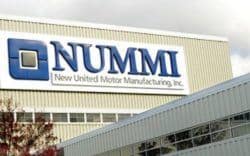 I really enjoyed my tour of the NUMMI plant last Friday. I'll post my summary thoughts and impressions from the tour, but I wanted to post a few of the more interesting stories first.
I really enjoyed my tour of the NUMMI plant last Friday. I'll post my summary thoughts and impressions from the tour, but I wanted to post a few of the more interesting stories first.
In a back part of the factory that led up to some offices, there was a very old looking and HUGE escalator that must have been at least three stories tall. It was bigger than your standard escalator and must have been there since the plant opened in the early 1960's.
The escalator was turned off and blocked off (we had stairs, and I assume, an elevator for anyone who needed it). There was a small State of California safety notice that had originally shut it down, I assume.
You might wonder at first, this is Toyota, the home of TPM. Can't they keep an escalator running?
A very large permanent sign above the escalator said something like:
“Sorry for inoperative
escalator. It would cost
$120k to repair. We feel
money could be better
spent on other things.
Please accept our apologies.”
Wow. The frugality and practicality of TPS was illustrated by that sign, our tour group thought. Rather than a knee-jerk reaction of fixing it when broken, somebody asked that powerful question: “Why?”
- Why fix the escalator when it's in a far back corner of the plant?
- Why fix the escalator when we have a perfectly good set of stairs, which are healthier to use?
- Why fix the escalator when somebody who can't walk might have to use the elevator anyway?
- Why spend the money there when it could be used to improve safety, quality, or the production process?
This wasn't the sequential “5 Why's”, but I think you see what I mean.
How often do you spend money because you “should” or because of history rather than really questioning that spending? “Why” is a very powerful word, a theme that will continue through my stories.
Another question I'm challenging myself with: If this had been a GM plant, would I be criticizing them for being cheap?
Go To NUMMI Tour Tale #2: The Power of Reynolds Wrap
Please scroll down (or click) to post a comment. Connect with me on LinkedIn.
If you’re working to build a culture where people feel safe to speak up, solve problems, and improve every day, I’d be glad to help. Let’s talk about how to strengthen Psychological Safety and Continuous Improvement in your organization.









What a fantastic observation. Your last question, regarding the possibility of viewing an escalator in disrepair as ‘cheap’ if observed at a GM plant is a good one, but is likely not the right question.
I would ask instead, “If the visual controls for the escalator, including the sign posted indicating the estimated cost to repair and the conscious decision not to were not in place, would you have criticized Toyota for being cheap?”
Why keep the escalator in the first place if it’s not running & not worth fixing?
Why invest resources to tear it down, when there is no reason to invest resources to make it run?
Why keep looking at something that doesn’t work?
Why allow a broken escalator that is safety risk & eyesore to remain when other forms of (more effective ways of) getting to the next floor are available?
Why have a concern for appearance, consistency, & flow, & have a form of transportation that is visibly un-useful?
(all other forms work; the stairs, the elevator; is it inconsistent to have a escalator in view that doesn’t? Why tempt people with the opportunity to use an escalator only to have them realize that option is not available? Why display the cost to fix & not display the cost to tear down & remove? Have the considerations for removing been “whyed”)?
My point is to say “why even have an escalator on site that hasn’t worked in years, & never will? Why not take it out & improve the space for consistency, flow, & appearance?” to me, an unused broken escalator (potentially dangerous) is more of an example of not wanting to invest in the long term than it is an example of a company asking why bother investing resources to fix it when other things exist to get to another floor. It would be like having an unusable fire escape w/a sign saying “do not use”.
I used to work at NUMMI. Yes, having the elevator was inconvenient, it was a bit of a hike to the top when I first started. But it just became easier and easier year after year. Nothing like good exercise, and of course gravity’s a great aid on the way down.
I’ve been in that plant. The escalator in question is not at the back of the plant, it’s at the front and connects the ground floor (where vehicle assembly takes place) with the level where offices and the lunchroom are. In my mind, NUMMI management is trying to make a virture out of a necessity by not fixing the elevator.
I talked to a retired Manager who stated they did a study and determined it was safer to walk up and down stairs then to use an escalator. After an injury did occur a study was conducted it was determined stairs was the safer method the escalator was placed out of service.
the cheap bastards cancelled all family fun days, christmas parties,etc. that stupid thing will never get fixed under this management!
working at nummi has become some what of a night mare to me.although i make good money it has come with a price,theres alot of racism there and the union and management dont seem to care.ive been labeled with a racist name that to some of my co workers is funny. to me cause of the money i have to put up with. management rewards bad team members with promotions. they also give over time and special privilages to them.working at nummi is not as good as you think it is.what ever happen to mutual trust and respect?its right there with the escalator. … forgotten
N.U.M.M.I. is involved in a discrimination lawsuit. (Race and Disability) The plaintifs are being represented by Angela Alioto of San Francisco.
I don’t get it…an escalator can never be out of order, it can only become stairs.
Sure, they become stairs, but stairs with really wide and steep steps. There is probably more of a tripping hazard compared to regular stairs, hence the need to block them off?
removing the escalator would be a wasteful expense.
NUMMI is currently run by people who no longer follow the concepts that formed it.
there are two lawsuits against NUMMI for 40 million and 45 million from two employees who were both treated with disrespect.
My Chevy Nova was built there in 1987, it runs great to this day, very very obvious quality went into this car…GM’s finest at the time…I heard they have NUMMI’s first car there, a white 1984 Nova, is this true?
I don’t know if I believe that the escalator causes more injuries than stairs. If that were the case, liability would push many companies to get rid of them. I think they do it for cost, but also to send a signal that money is not cheap. I worked there and at GM and NUMMI is much more cost conscious. It starts with a cheapskate frugal attitude so everyone doesn’t ask for something unless it is needed. It’s like growing up as a kid rich vs poor. Rich kids used to Mom and Dad getting everything for them will not voluntarily give up for practicality. They will gravitate to convenience. Middle class or poor kids know not even to ask for things that are out of reach. My wife grew up poor and she has the eye on the dollar and it is a good thing. I grew up upper middle class and knew I got a way with a lot at home for things I didn’t need, but wanted. I could always pitch a case to justify “need”. Things don’t change in human nature when they work for a corpporation. Many will waste company money to make their personal lives easier at work. So the culture of being frugal is there. They eliminated waste baskets and seemed kind of dumb, but we do fine without them. Watch the pennies and the dollars will take care of themselves. But it is a tough place to work, but you do learn alot and it changes your point of view.
I used to work there at NUMMI. I gave 1 1/2 years of dedicated hard work without benefits only to be shown the door like many others before and after me. Meanwhile, fraudulent disabilities sit at home collecting a paycheck because this union (UAW) continues to protect the weak and unworthy. This company is poisoned and I look forward to the day they close their doors for good.
I worked at that plant for both GM, and for the NUMMI joint venture. It is important to note that the escalator's primary function was access to the cafeteria, and that it is flanked on both sides by stairs. The stairs are much easier to negotiate. In fact, I used to use the stairs even when the escalator was working.
The 'positive' Toyota influenced NUMMI culture seemed to evaporate after the departure of Gary Convis. Gary was Executive VP of manufacturing at NUMMI and left to become the President of the Georgetown Kentucky operations. Gary had successfully internalized the Toyota Culture, and I'm my opinion was having difficulty spreading it to the rest of the NUMMI management team. I have heard from others that the management culture at NUMMI has since moved closer to the 'Old' GM style after Gary's departure.
[…] NUMMI Tour Tale #1: Why Fix the Escalator? […]
Why was it installed in the first place? Wasted $ by design.
[…] NUMMI, by any stretch. My earlier posts about a plant tour I was on two years ago sometimes bring random and angry comments from people claiming to be NUMMI employees. The quality reputation of NUMMI is good, as judged by […]
[…] by Mark Graban on October 26, 2005 · 4 comments NUMMI Tour Tale #1: Why Fix the Escalator? […]
[…] is one that mirrors what I saw at NUMMI, where I saw Toyota with large quality mottos hanging from the rafters: “Don’t hesitate […]
[…] Click the “NUMMI” link at the bottom of the post for more/old stories about NUMMI, including my tour there in 2005. […]
[…] was able to tour the NUMMI factory in 2005, which I really enjoyed (see my series of blog posts here). NUMMI was, of course, a joint venture between Toyota and GM (as John Shook talked about recently […]
[…] NUMMI Tour Tale #1: Why Fix the Escalator? NUMMI Tour Tale #2: The Power of Reynolds Wrap NUMMI Tour Tale #3: The Power of Why […]
[…] can revisit them, by starting with Tale #1 and continuing on from […]
[…] NUMMI Tour Tale #1: Why Fix the Escalator? NUMMI Tour Tale #2: The Power of Reynolds Wrap […]
[…] the lean production system at work, visit Mark Graban’s Lean blog for a six part series of NUMMI Tour Tales. For an in-depth study on how Toyota approached the joint venture at NUMMI, the paper titled […]